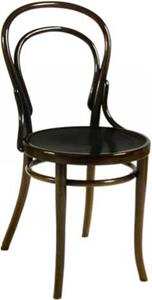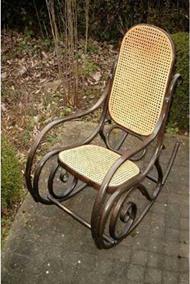During the eclectic period, homage was paid to short-lived trends that were based on former historical styles. This wave of sentiments sparked interior designs in Turkish, Persian, Indian, Chinese and Japanese style. All of these stylish trends put together gradually led to the internal disintegration of Biedermeier style. In addition, they resulted in the collapse of an established furniture art, shaped on the healthy centuries’ old craft traditions. The progressing industrialisation contributed to ousting craft workshops that constituted forges of talents and a place of collaboration for artists with craftsmen. Nevertheless, the industry contributed to the creation of a separate branch of furniture making—furniture manufactured in series and packed in boxes. This group of furniture constituted curved furniture.
In 1830, the German carpenter Michael Thonet (born in 1796 in Boppard on the Rhine, the son of a German tanner Franz Anton Thonet), wanted to avoid the costs associated with wood milling, he began experimenting with wood bending techniques. Initially, he immersed properly prepared strips of veneer in tubs of boiling glue, which after taking them out, he would bend and glue using presses in special moulds. Unfortunately, the bent glued elements obtained from this, due to insufficient properties of adhesive and wood, could not be formed into shapes that the creator expected from the future structural elements of furniture. After carefully observing the behaviour of wood fibres, Thonet perfected his technology and became the first producer in the world of curved wooden elements. In 1841, Thonet demonstrated for the first time his own-designed and manufactured furniture made of curved wood at an exhibition organised by Koblenz Art Association. There, he also met the Austrian Prince Metternich, who invited him to Vienna, where in 1849 he began mass production of furniture using the technique of bending wooden rods. For the production of furniture, Thonet used mainly beech wood, which in industrial conditions was easily subject to this technology. An advantage of this technology was also that it did not require from workers any special talents or skills. Thonet was ahead of his time and discovered a new market of affordable furniture produced in long series and intended for both the bourgeoisie and offices or cafes. Thonet’s factories mainly manufactured chairs (Fig. 1.48) (chair model no. 14 was manufactured in more than 45 million copies with a 40 year period), armchairs, beds and rocking chairs (Fig. 1.49), living room sets, dining room sets and bedroom sets.
Fig. 1.48 Chair model 14, designed by Michael Thonet, 1859-1860

 Fig. 1.49 Rocking chair, designed by Michael Thonet
Fig. 1.49 Rocking chair, designed by Michael Thonet
The seats of the armchairs and chairs were carried out in three variants:
• from plywood, with a burnt out or pressed design, or with holes drilled in a decorative arrangement,
• weaved with Spanish reed,
• upholstered (leather or fabric).
The elements of furniture, especially skeletal furniture, were joined using mortise and tenon joints with a threaded stud and screws, which made it possible to disassemble the furniture for transport. Thonet’s furniture is lightweight and durable, which they owe to the elimination of certain joints from the skeletal structure, so that one element fulfils a few functions. Characteristic of them is the openwork lightness of structure and the effect of transparency, and their style remained independent of the art of past periods.
After 1929, Thonet’s factories begin mass production of curved furniture also made of steel tubes. Thonet’s furniture is lightweight, often with the possibility of disassembling for transport, and also quite durable. They were always labelled with stickers with the name: Thonet, Thonet Brothers—Vienna (from 1853) or Thonet— Mundus (from 1923). A significant part of the production of curved furniture has also been located in Poland: in Radomsko, Jasienica, Jaworze and Buczkowice.



